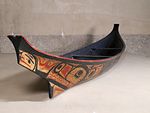Hunclee-quilas
About this object
History of use
Canoes were used for fishing and hunting, trading, voyaging and war. Important canoes were carved or painted with family crest figures on the prow.
Narrative
The boat was made in Kitamaat, by members of the Kitamaat Athletic Club, and was presented to G.G.E. Raley (Captain Emsley) as a wedding present in 1941. The canoe was given the name Hunclee-quilas, or Han-Tli-Kwe-Lough, in honour of the Chief who first established Kitamaat Village. Raley donated the canoe to the Museum of Anthropology in 1948 to give it a permanent home in British Columbia. The original painting, of a crest motif with arrows, flanked by an eagle and a killer whale, was obscured in 1967 when the canoe was over-painted by Haida artist Bill Reid, in a Haida design—possibly for a special exhibition.
Physical description
Wooden northern style canoe with a Haida design painted on the outside. The canoe is painted black with Northwest Coast stylized designs on the ends in red, white and black. Depicted on each side is a Killer whale with its head and dorsal fin on the prow and the body and tailfins on the stern. There is a red border around the upper edges. The ends sweep upwards. The prow is grooved to hold a harpoon or mast and has a vertical fin to cut through waves. The interior is also painted black and has three rectangular bench seats.
Categories
Materials
